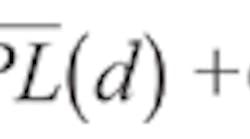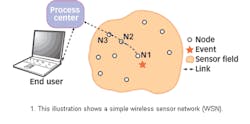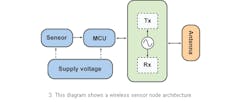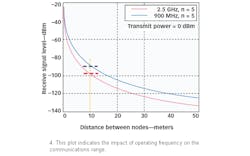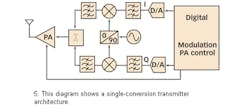Building Wireless Sensor Networks
This file type includes high resolution graphics and schematics when applicable.
Wireless sensor networks (WSNs) offer great promise for information capture and processing in both commercial and military applications. Successful system design and deployment includes understanding RF channel characteristics, and the choice of modulation scheme on power consumption. Such factors ultimately determine the available range and data rate of a WSN, as well as cost and battery lifetime.
The increasing miniaturization of RF devices and microelectromechanical systems (MEMS) and the advances in wireless technologies, has generated a great deal of research interest in the area of wireless sensor networks (WSNs). Sensor networks provide a promising infrastructure for gathering information about parameters of the physical world.1-3 Such networks have many applications in military and civilian environments.
WSNs employ a large number of miniature autonomous devices known as sensor nodes to form the network without the aid of any established infrastructure (Fig. 1).
In a wireless sensor system, the individual nodes are capable of sensing their environments, processing the information locally, or sending it to one or more collection points through a wireless link. Each node has a short-range transmission due to low RF transmit power. Short-range transmission minimizes the possibility of the transmitted signals being eavesdropped; also, it helps in prolonging the lifetime of the battery. In some sensor system applications, the nodes are hard to reach and it is impossible to replace their batteries. In other applications, the nodes must operate without battery replacement for a long time. Such conditions make the system power consumption a very crucial parameter.
WSNs use ad hoc topology because of its ease of deployment, and decreased dependence on infrastructure. Although WSNs use ad-hoc architecture, this architecture is different from the conventional wireless ad hoc networks (Table 1). The performance of a WSN depends significantly on the characteristics of the sensor node.4-6 Figure 2 shows commercial wireless sensor nodes (courtesy of Crossbow Technology, Inc., San Jose, CA, www.xbow.com)7 while Fig. 3 depicts the system-level architecture of a WSN.
The node subsystem consists of a sensor or sensors for sensing the environment, microcontroller unit for processing and controlling the signals from the sensors, the RF transceiver for transmitting (Tx) and receiving (Rx) RF signals, antenna element for interfacing the transceiver with the physical environment, and power supply for providing the supply voltage to all the blocks of the node.
In WSNs, the RF channel is susceptible to a variety of propagation impairments such as interference, reflections, scattering, and shadowing. These factors influence the system performance and cost, and need to be modeled accurately. Since the size of the sensor nodes is a design constraint, therefore, the choice of the operating frequency is a key design parameter. In sensor systems, the transmission data rate is low in comparison with other wireless technologies such as WLAN 802.11, WiMAX, and Bluetooth, therefore, the modulation type needs to be power efficient rather than spectral efficient in order to extend the lifetime of the nodes. An important issue, which could degrade the system performance significantly, is the radio interference from other systems or from node to node within the system. All these RF system issues will be discussed in the subsequent sections.
In any wireless system, RF channel propagation path loss is the basic parameter used in the system link budget analysis to estimate the received signal strength at the input of a given node. For sensor systems deployed according to site planning, classical propagation models8 for predicting the average path loss can be used. However, for randomly deployed sensor systems where the nodes might be buried in moist ground and covered by vegetation or other obstructing objects, these classical propagation models might not be valid for predicting the propagation path loss of a link of a source-destination pair of nodes. Therefore, characterization and modeling of the propagation path loss of randomly deployed sensor systems is necessary for the design and deployment of a robust sensor system.
The most fundamental choice to be made in the design and development of a wireless sensor system is the selection of the operating frequency. It must comply with government regulations and wireless standards. Currently, frequencies used for wireless sensor systems include 315 MHz, 433 MHz, 868 MHz (Europe), 915 MHz (North America), and the 2.45-GHz Industrial-Scientific-Medical (ISM) band. The 2.45-GHz band provides implementation flexibility due to the abundance of commercially available RF devices in that band. However, the basic concern of using this band is the possibility of intersystem interference. Interference can come from a number of applications in the band, including WLAN 802.11b/g, WiMAX, and Bluetooth. Therefore, spread-spectrum technology or frequency-agile techniques might be needed to mitigate interference.
Using lower frequencies would help in extending the communications range due to low path loss attenuation. With low propagation path loss, the antenna gain would not become an important factor in the system link budget. However, low frequencies require larger sized antennas. If the density of deployment allows for few meters spacing between the nodes, the choice of lower frequencies would be a good choice. Very low operating frequencies (70 MHz or even lower) may provide better solutions for some wireless sensor applications. Table 2 shows the frequencies and communications ranges of some commercial WSNs.
From Table 2, for data rate of 38.4 kbaud and operating at 433 MHz, the current drawn is 25 mA. Achieving the same data rate but at 868/916 MHz requires 27 mA current. In addition, the communication range of the 433-MHz systems is twice the range of the 868/916-MHz systems. Therefore, choosing low frequencies would contribute to power savings and extending the system reach.
Figure 4 illustrates the effect of the operating frequency on the power at a receiving node, PR(d), as a function of the distance from the transmitter.
Power PR(d) is modeled using a log-normal shadowing model8 as follows:
where:
Pt = the transmit power,
Gr = the receivce antenna gain,
Gt = the transmit antenna gain, and
____
PL(d) = the average path loss at a distance d from the transmitter, given by
and
where:
PLo(do) = the free-space path loss at a reference distance do,
λ = the wavelength of the carrier,
n = the path loss exponent (which depends on the propagation environment), and
Xσ = the shadowing term (the zero-mean Gaussian random variable in dB with standard deviation of σ).
The results of Fig. 4 are based on transmit and receive antenna gains of 0 dBi, transmit power of 0 dBm, a path loss exponent of 5, Xσ of 8 dB, and operating frequencies of 900 and 2500 MHz. From Figure 4 it is clear that, at a distance of 10 m from the transmitter, operating at 900 MHz results in approximately 10 dB improvement in the received signal power in comparison with operating at 2.5 GHz. Such an improvement allows reducing the transmit power which prolongs the lifetime of the node.
In contrast, for future wireless sensor systems that require very small size nodes, "smart dust,4" and very high density of deployment (i.e., nodes are spaced by few centimeters), the best suited operating frequency might be the millimeter wave bands (i.e., 70 GHz or above).9 The advantage of these high frequencies include small size antennas, frequency reuse, and low power consumption. However, these very short-range wireless links may involve routing issues.
The antenna element is one of the key components in any sensor system, because it is the interface between the RF channel and the system's hardware. Successful transmission and reception of data between the sensor nodes requires high-efficiency antennas10 because of low transmitted power and the limitations imposed on the antenna size. Antennas for sensor systems can be directional or omnidirectional depending on the system application. Directional antennas help in reducing the effects of interference as well as in extending the communication range of the system, but provide limited coverage because of their directional characteristics. Using omnidirectional antennas enable covering all the spots equally, but they have shorter range and could pick up undesired signals.
Page Title
For randomly deployed systems, although, the antenna element is sealed inside the node, the surrounding objects that may cover the nodes could distort the antenna radiation pattern. Conducting objects create the most severe pattern distortion. Those objects with dimensions near the length of the antenna behave as parasitic elements of an uncontrolled array, producing random nulls in the antenna radiation pattern. Nonconducting objects can also distort the radiation pattern. Therefore, different nodes might exhibit different radiation patterns, and the antenna gains of a link of a source-destination pair of nodes may vary from one hop to another within the system. Consequently, the coverage area will be impacted by the antenna radiation pattern. Characterization of the radiation pattern of a randomly deployed system, would be very useful for developing and deploying efficient and cost-effective sensor systems.
In a wireless sensor system, RF transmissions encounter two classes of interference: intrasystem interference (interference from node to node) and intersystem interference (interference from other systems which operate at the same frequencies as the nodes). The accumulated interference level at the victim node reduces the signal-to-interference plus noise ratio (SINR), which desensitizes the receiver of the victim node and degrades the system throughput. The SINR can be estimated by:
where:
Pr = the desired received signal power,
Ii = the signal power from the ith interfering node,
Ik = signal power from the kth external interfering source, and
No = the receiver's thermal noise power.
The SINR depends on the distance between the victim node and the interfering sources, the strength of the desired signal, and the strength of the interfering signals. In the case where a system is based on collision-avoidance design, all nodes do not transmit at the same time. and intrasystem interference would not be as critical as intersystem interference. Because of the low transmit power of the nodes, intersystem interference could be a concern in sensor systems. Low SINR degrades the system's BER, as well as the capacity of the system, which is expressed as:
where:
C = the system capacity (b/s) and
B = the system bandwidth (Hz).
For WSNs, capacity is not a major issue since each node operates at low data rates. Characterization and modeling of RF interference in a WSN would be essential for ensuring the coexistence of the systems with other wireless technologies. Such technologies include IEEE 802.11 b/g wireless local-area networks (WLANs), WiMAX, Bluetooth, cordless phones, and ultrawideband (UWB).
Designing transmitters for sensor systems requires careful consideration for choosing the modulation scheme. There are many important criteria for choosing the most suitable modulation scheme, including power consumption,11, 12 transmit power, and cost. The limited power supply in sensor systems mandates that the transmitter operates under nonlinear conditions.
Since power consumption is a design constraint, power-efficient modulation such as binary frequency-shift keying (BFSK) could be a good candidate for a WSN. BFSK is a form of constant-envelope modulation, which allows the transmit power amplifier (PA) to operate in a nonlinear condition.
Besides the choice of the modulation scheme, the choice of transmitter architecture can also contribute to power savings. This can be achieved by using RF blocks that draw low current. Transmitters based on multiple frequency upconversion and filtering stages do not comply with low-cost and low-power requirements. Efficient generation of the transmit signal can be achieved by using a single in-phase/quadrature (I/Q) upconversion topology (Fig. 5).
The PA is the most power-hungry block in the transmitter. However, the choice of modulation scheme affects the requirements for peak-to-average power ratio, and can contribute to a power savings in the transmitter.
In summary, designing an effective WSN involves extensive knowledge of the propagation environment, where performance can be compromised by hidden sensor nodes or sensors covered by vegetation. An accurate propagation model is essential for developing a cost-effective WSN. In addition, the choice of frequency has a significant effect on system performance. Lower frequencies suffer less path loss and better range than higher frequencies, although higher frequencies result in smaller sensor nodes. For very small size nodes and very high-density deployment, millimeter-wave frequencies of 70 GHz and higher offer miniature antennas and the chance for frequency reuse. But, at these high frequencies, routing issues may be a problem.
In WSNs, low node transmit power makes the system susceptible to radio interference.
Thus, an interference assessment is essential for efficient system design and deployment. In some WSN applications, nodes are deployed randomly and may be hidden or blocked by other objects, in which case the radiation characteristics of the node antennas may be affected. Therefore, measurements of the radiation pattern of the nodes in different environments would help in predicting the system performance.
ACKNOWLEDGMENTS
The authors would like to acknowledge the Defence Research and Development Canada-Valcartier for sponsoring this and other research activities in the area of wireless sensor networks. Special thanks to Mr. Luc Boucher of the Communications Research Centre Canada for good suggestions and discussions, as well as for his support for this work.
REFERENCES
- C. Chong and S. Kumar, "Sensor Networks: Evolution, Opportunities, and Challenges," Proceedings of the IEEE, Vol. 91, No. 8, August 2003.
- I. Akylindiz et al., "A Survey on Sensor Networks," IEEE Communications Magazine, August, 2002.
- J. Kahn, R. Katz et al., "Emerging Challenges: Mobile Networking for Smart Dust," Department of Electrical Engineering and Computer Science, University of California, Berkeley, CA.
- J. Khan, R. Katz, and K. Pister, "Next Century Challenges: Mobile Networking for Smart Dust," http://www.ee.stanford.edu/~jmk/pubs/mobicom.99.pdf.
- R. Min et al., "Low-power Wireless Sensor Networks," Proceedings of the 14th International Conference on VLSI Design, 2000, p. 205.
- J. Hill et al., "System Architecture Directions for Networked Sensors," University of California, Berkeley, CA, 2000.
- Crossbow Technologies, Internet: http://www.xbow.com/.
- T. Rappaport, Wireless Communications, Principles and Practice, Prentice-Hall, Upper Saddle River, NJ, 1996.
- I. Haroun, R. Hafez et al., "Millimeter-Wave Bands for Indoor Wireless Systems," Wireless World Research Forum (WWRF12), Toronto, Canada, November 2004.
- C. A. Balanis, Antenna Theory: Analysis and Design, 2nd ed., Wiley, New York, 1997.
- V. Raghunathan et al., "Energy-Aware Wireless Sensor Networks," Department of Electrical Engineering, University of California, Los Angeles, CA 90095.
- C. Shuguaqng et al., "Energy-Constrained Modulation Optimization for Coded Systems," Department of Electrical Engineering, University of California, Stanford, CA 94305.
This file type includes high resolution graphics and schematics when applicable.
